
The Enermax LiqMaxFlo 360mm AIO Cooler Review: A Bit Bigger, A Bit Better
2024-02-14For established PC peripheral vendors, the biggest challenge in participating in the highly commoditized market is setting themselves apart from their numerous competitors. As designs for coolers and other peripherals have converged over the years into a handful of basic, highly-optimized designs, developing novel hardware for what is essentially a “solved” physics problem becomes harder and harder. So often then, we see vendors focus on adding non-core features to their hardware, such as RGB lighting and other aesthetics. But every now and then, we see a vendor go a little farther off of the beaten path with the physical design of their coolers.
Underscoring this point – and the subject of today’s review – is Enermax’s latest all-in-one (AIO) CPU cooler, the LiqMaxFlo 360mm. Designed to compete in the top-tier segment of the cooling market, Enermax has opted to play with the physics of their 360mm cooler a bit by making it 38mm thick, about 40% thicker than the industry average of 27mm. And while Enermax is hardly the first vendor to release a thick AIO cooler, they are in much more limited company here due to the design and compatibility trade-offs that come with using a thicker cooler – trade-offs that most other vendors opt to avoid.
The net result is that the LiqMaxFlo 360mm gets to immediately start off as differentiated from so many of the other 360mm coolers on the market, employing a design that can give Enermax an edge in cooling performance, at least so long as the cooler fits in a system. Otherwise, not resting on just building a bigger cooler, Enermax has also equipped the LiqMaxFlo 360mm with customizable RGB lighting, allowing it to also cater to the aesthetic preferences of modern advanced PC builders. All together, there’s a little something for everyone with the LiqMaxFlo 360mm – and a lot of radiator to cram into a case. So let’s get started.
| Enermax LiqMaxFlo 360mm AIO CPU Cooler Specifications | |||
| Type | All-in-One Liquid Cooler | ||
| Dimensions | 397 x 120 x 63 (radiator with fan)
54 x 54 (coldplate) |
||
| Fans | 3 x 120 mm UCSFARGB12P-LMF FDB Bearing Fans 1800 RPM (max) |
||
| RGB | Yes (ARGB) | ||
| Supported Sockets | Intel: LGA1700 / LGA1200 / LGA115x / 2066 / 2011 / 1366
AMD: AM5 / AM4 |
||
| Warranty | 5 Years | ||
| Price | $128 | ||
Enermax packages the LiqMaxFlo 360mm AIO CPU cooler in a striking red and black box, its dimensions indicative of the cooler’s size. The front of the box features a picture of the LiqMaxFlo, showcasing its design and highlighting the presence of RGB lighting. Inside, the cooler is securely nestled within tailor-made cardboard inserts, meticulously designed to safeguard the cooler during shipping and handling, ensuring it arrives in pristine condition.
Enermax ensures that the LiqMaxFlo 360mm AIO CPU cooler is not only ready to use out of the box but also equipped for long-term maintenance. The package includes a 100ml bottle of cooling liquid, a syringe with thermal compound, and a PSU jump-starting plug, in addition to the essential mounting hardware. The cooler can be installed on most modern CPU sockets, excluding Threadripper processors.
Upon initial inspection, the Enermax LiqMaxFlo 360mm AIO CPU cooler exhibits a design that is consistent with the conventional layout of most 360 mm AIO coolers available in the market. This cooler adheres to the standard AIO configuration, comprising a single radiator, two hoses, and a unified block. The block integrates a copper CPU contact plate with a compact liquid pump, a typical setup in modern AIO liquid cooling solutions. Enermax is using typical rubber hoses with nylon sleeving over them for additional protection, which are functional but not very flexible.
As noted in the intro of this article, the highlight of the LiqMaxFlo 360mm AIO is its above-average 38mm thick radiator. Coupled with its 25mm thick fans (which unlike the radiator, are industry-standard sized), the complete radiator/fan assembly requires a total clearance of more than 63mm (~2.5 inches) within a PC case. This is not an outrageous size by any means, but it is notable since there are plenty of cases that are designed to take AIO coolers and assume a standard 52mm rad/fan thickness. So Enermax is sacrificing a degree of case compatibility here in order to use a thicker radiator – something prospective buyers will want to be sure to double-check before making any hardware purchases.
The design of the radiator follows the common dual pass cross-flow configuration, with small fins attached to thin, elongated tubes. A notable design element of the LiqMaxFlo cooler is the prominent chrome series logo on the sides of the radiator, adding a distinct visual touch that stands out, especially when installed inside a PC case. There also is a tap at the bottom of the radiator, allowing the refilling of cooling liquid should that prove necessary. The position of the tap necessitates the removal of the entire cooler from the system prior to such maintenance.
The main block of the Enermax LiqMaxFlo 360mm AIO cooler is thoughtfully designed with customization in mind. It is mostly made out of plastic, with a top cover that is removable and replaceable. This unique feature offers considerable customization possibilities, making it particularly appealing to 3D printer owners who can create their own designs. The block is equipped with 90° fittings on its side to accommodate both hoses, and two cables emerge from this area: a 4-pin power cable and another for the RGB lighting. The RGB lighting can be connected either to the included controller or to any compatible RGB controller, providing flexibility in lighting setup and customization.
The main block also has a small cooling fan attached to it, but it’s not for the cooling of the CPU (or the block) itself. Rather, it’s for providing airflow to keep down the temperature of power components adjacent to the CPU socket. Inside the block lies a unique pump and channel design by Enermax, who claims it offers significantly higher liquid pressure than other designs.
At the bottom of the main block assembly, we can see a squircle contact plate that is attached to the plastic base cover with eight screws. Its surface is not polished down to a mirror finish but is adequately smooth and flat. A quality thermal compound (Dow Corning TC-5888) is already pre-applied to the base – the bundled thermal compound syringe is for future use only and should not be used when first installing the cooler. The contact plate is just large enough for socket LGA-1700 and AM5 processors.
Enermax provides three of their own UCSFARGB12P-LMF 120 mm with the LiqMaxFlo 360mm AIO cooler. These are high pressure fan designs, with just five wide blades per fan, a solid choice from an engineering point of view considering the thick radiator. They have an operational range of 500 to 1800 RPM, which is very good for 120 mm fans and should allow the LiqMaxFlo to have a wide operational range. The fan cables are very short, allowing multiple fans to be connected in parallel (daisy-chain) with only one extension wire providing power to the array. Enermax combined the RGB and power wiring into one, resulting to a single 8-pin connector per fan and, thus, less cable clutter.
Enermax did not try to reinvent the wheel when it comes to the RGB lighting, going for the classic semi-transparent fan hub design with the LEDs installed inside the hub. This includes the small 60 mm fan inside the CPU block. The lighting is fairly bright and adequately even, with the brightness diminishing towards the edge of the fans. Lowering the brightness reveals lighting gaps to the naked eye, as the hub’s radius is too small and the installed LEDs too few to conceal that effect. It is not an outstanding implementation by today’s standards yet we consider it passable for the greatest percentage of users, excluding those that are particularly picky regarding the aesthetic appearance of their systems.
Although the testing of a cooler appears to be a simple task, that could not be much further from the truth. Proper thermal testing cannot be performed with a cooler mounted on a single chip, for multiple reasons. Some of these reasons include the instability of the thermal load and the inability to fully control and or monitor it, as well as the inaccuracy of the chip-integrated sensors. It is also impossible to compare results taken on different chips, let alone entirely different systems, which is a great problem when testing computer coolers, as the hardware changes every several months. Finally, testing a cooler on a typical system prevents the tester from assessing the most vital characteristic of a cooler, its absolute thermal resistance.
The absolute thermal resistance defines the absolute performance of a heatsink by indicating the temperature rise per unit of power, in our case in degrees Celsius per Watt (°C/W). In layman’s terms, if the thermal resistance of a heatsink is known, the user can assess the highest possible temperature rise of a chip over ambient by simply multiplying the maximum thermal design power (TDP) rating of the chip with it. Extracting the absolute thermal resistance of a cooler however is no simple task, as the load has to be perfectly even, steady and variable, as the thermal resistance also varies depending on the magnitude of the thermal load. Therefore, even if it would be possible to assess the thermal resistance of a cooler while it is mounted on a working chip, it would not suffice, as a large change of the thermal load can yield much different results.

Appropriate thermal testing requires the creation of a proper testing station and the use of laboratory-grade equipment. Therefore, we created a thermal testing platform with a fully controllable thermal energy source that may be used to test any kind of cooler, regardless of its design and or compatibility. The thermal cartridge inside the core of our testing station can have its power adjusted between 60 W and 340 W, in 2 W increments (and it never throttles). Furthermore, monitoring and logging of the testing process via software minimizes the possibility of human errors during testing. A multifunction data acquisition module (DAQ) is responsible for the automatic or the manual control of the testing equipment, the acquisition of the ambient and the in-core temperatures via PT100 sensors, the logging of the test results and the mathematical extraction of performance figures.
Finally, as noise measurements are a bit tricky, their measurement is being performed manually. Fans can have significant variations in speed from their rated values, thus their actual speed during the thermal testing is being recorded via a laser tachometer. The fans (and pumps, when applicable) are being powered via an adjustable, fanless desktop DC power supply and noise measurements are being taken 1 meter away from the cooler, in a straight line ahead from its fan engine. At this point we should also note that the Decibel scale is logarithmic, which means that roughly every 3 dB(A) the sound pressure doubles. Therefore, the difference of sound pressure between 30 dB(A) and 60 dB(A) is not “twice as much” but nearly a thousand times greater. The table below should help you cross-reference our test results with real-life situations.
The noise floor of our recording equipment is 30.2-30.4 dB(A), which represents a medium-sized room without any active noise sources. All of our acoustic testing takes place during night hours, minimizing the possibility of external disruptions.
| <35dB(A) | Virtually inaudible |
| 35-38dB(A) | Very quiet (whisper-slight humming) |
| 38-40dB(A) | Quiet (relatively comfortable – humming) |
| 40-44dB(A) | Normal (humming noise, above comfortable for a large % of users) |
| 44-47dB(A)* | Loud* (strong aerodynamic noise) |
| 47-50dB(A) | Very loud (strong whining noise) |
| 50-54dB(A) | Extremely loud (painfully distracting for the vast majority of users) |
| >54dB(A) | Intolerable for home/office use, special applications only. |
*noise levels above this are not suggested for daily use
Our maximum speed testing is performed with both the fans and the pump of the kit powered via a 12V DC source. This input voltage should have the pump and fans matching the speed ratings of the manufacturer. According to the company’s specifications, the included Enermax fans should have a rotational speed of 1800 RPM. Our tachometer indicated that the fans were rotating at an average speed of 1770 RPM, close to the rated specifications and consistent to each other. The divergence is due to the high airflow resistance of the radiator.


| Core Temperature, Constant Thermal Load (Max Fan Speed) |
The Enermax LiqMaxFlo 360mm cooler exhibits notable performance across different load conditions, achieving an average thermal resistance of 0.067 °C/W at its maximum fan speed of 1770 RPM. The thermal performance of the cooler is relatively consistent regardless of the load. This performance is particularly impressive considering the cooler’s fan speed is fairly low compared to competitive products.
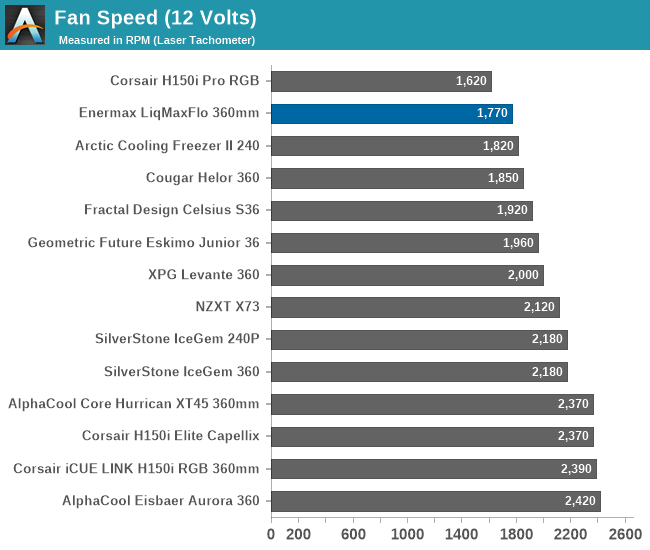
The Enermax LiqMaxFlo 360mm cooler, with a sound pressure level (SPL) of 38.6 dB(A) at full fan speed, stands out with its relatively low noise output for a cooler equipped with three 120mm fans. While this is still loud enough to be audibly noticeable, it’s some of the best results we’ve seen for a 360mm cooler. This achievement is particularly noteworthy given the inclusion of an additional fourth 60mm fan on the CPU block, which does contribute to higher noise levels. Despite the potential for increased sound from the extra fan, the LiqMaxFlo maintains a noise level that is quite moderate.
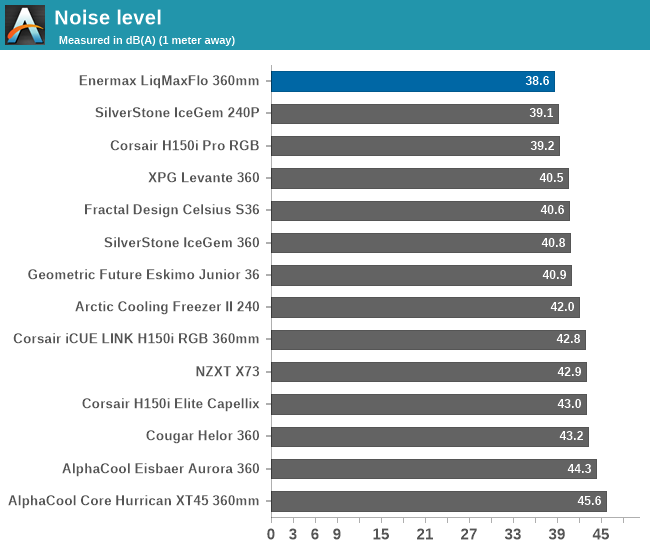
Using a PWM voltage regulator, we reduced the speed of the fans manually down to half their rated speed. At this setting, the 120 mm UCSFARGB120P-LMF fans of the LiqMaxFlo rotate at 850 RPM. Note that the speed of the 60 mm fan is also halved, yet this does not affect the results of our thermal testing.
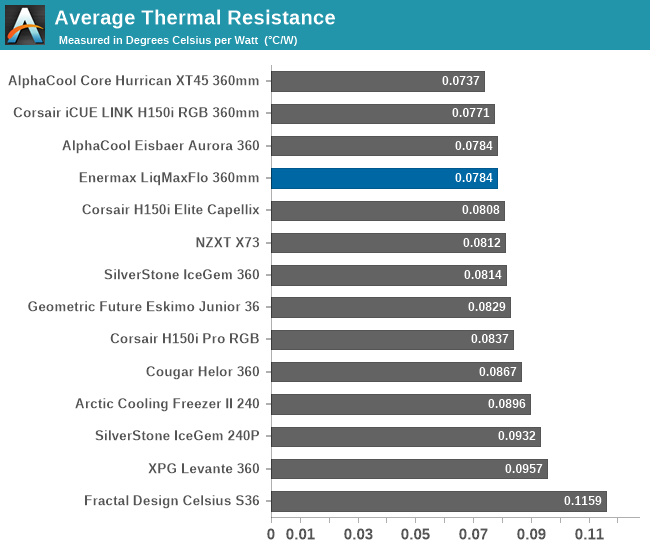

| Core Temperature, Constant Thermal Load (Low Fan Speed) |
The Enermax LiqMaxFlo 360 mm cooler displays excellent cooling efficiency with its fans running at 850 RPM, resulting to an average thermal resistance of 0.0784 °C/W. This figure brings it near the top of our charts, reaching figures that compete even with much more expensive and complex open loop liquid cooling kits.
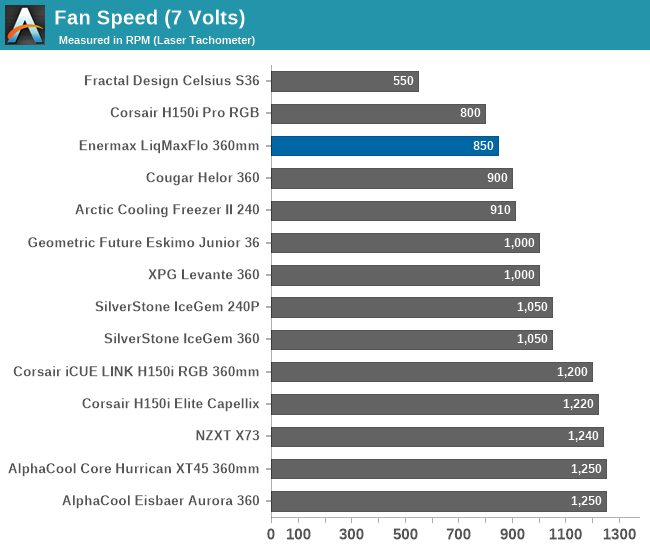
The acoustic performance of the Enermax LiqMaxFlo 360mm cooler is commendable, particularly when its fans are operating at half speed. At this reduced speed of 850 RPM, the cooler maintains a relatively low noise level of 33.4 dB(A), positioning it as one of the quietest cooling solutions that utilize three cooling fans.
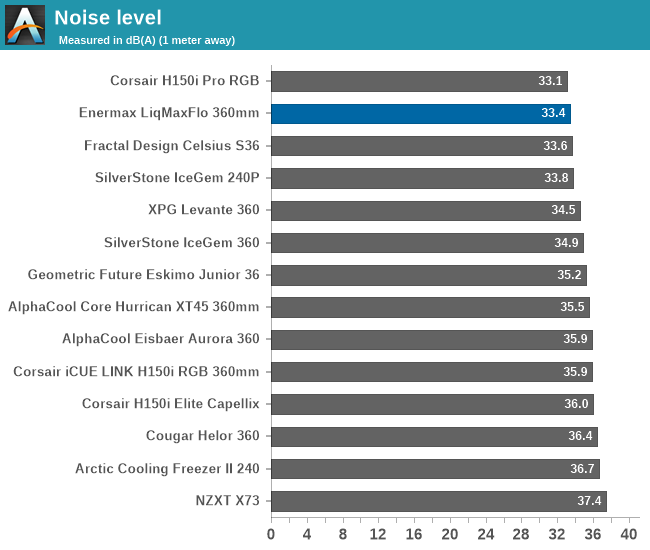
During our thermal resistance vs. sound pressure level test, we maintain a steady 100W thermal load and assess the overall performance of the coolers by taking multiple temperature and sound pressure level readings within the operating range of the stock cooling fans. The result is a graph that depicts the absolute thermal resistance of the cooler in comparison to the noise generated. For both the sound pressure level and absolute thermal resistance readings, lower figures are better.
This chart provides insightful revelations about the Enermax LiqMaxFlo 360mm cooler’s capabilities. It demonstrates that the LiqMaxFlo can deliver thermal performance comparable to its similarly sized competitors, but with notably less noise. The impressive results are not attributed to any extraordinary innovation; rather, they are the product of a thoughtfully designed thick radiator combined with optimally sized fans. This strategic design significantly enhances the cooler’s thermal efficiency. The only instance where the LiqMaxFlo is surpassed is by a considerably more costly and larger open-loop liquid cooling system.
The Enermax LiqMaxFlo 360mm AIO Liquid Cooler is a significant offering in the highly-competitive cooling market, catering to both enthusiasts and general users. It strikes an impressive balance between performance and aesthetics, making it a versatile choice for various PC builds. The design maintains the standard AIO layout but is distinguished by unique features, including a thick 38 mm radiator, durable nylon-sleeved rubber tubing, and a customizable main block with an additional 60mm fan for enhanced cooling. However, the thickness of the radiator is a double-edged sword, as it offers an edge on thermal performance but also could result to compatibility issues.
Aesthetically, the LiqMaxFlo combines functionality with sleek modernity. The main block’s plastic construction with a customizable top cover, and integrated RGB lighting, adds a personal touch. The radiator, with its prominent chrome series logo, offers a subtle visual standout. Its practical design includes a tap for coolant refilling, underscoring the cooler’s thoughtful engineering for long-term use. The UCSFARGB12P-LMF 120 mm fans, designed for high pressure with wide blades and with a healthy operational speed range, complement the cooler’s visual and functional attributes. The application of RGB lighting could have been better but it is not by any means poor, just average for a top-tier product.
Performance-wise, the LiqMaxFlo demonstrates its strength in providing consistent and efficient cooling. It achieves an impressive average thermal resistance of 0.067 °C/W at a maximum fan speed of 1770 RPM, while maintaining a relatively low noise level of 38.6 dB(A). At half fan speed, 850 RPM, it continues to perform admirably, maintaining a low noise level and effective cooling. Although it may not surpass the more expensive open-loop systems, its performance in terms of thermal efficiency and acoustics is highly competitive in its class.
The Enermax LiqMaxFlo 360mm cooler, with its effective performance and appealing design, is positioned as a strong contender in the advanced cooling market. Its combination of performance, aesthetic appeal, and thoughtful features make it an enticing choice for a variety of PC builds. However, users will have to first verify that their system is spacious enough for the 38 mm thick radiator, which requires significantly greater clearance than most competitive products. For users looking for a well-rounded cooler in terms of performance and visual appeal, the Enermax LiqMaxFlo 360mm emerges as an attractive option, all at a very reasonable price point of $128.














